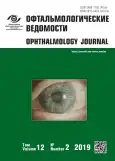Vitrocap efficacy in patients with the vitreous body destruction
- Authors: Varganova T.S.1, Veryasova A.G.1, Erysheva E.D.2
-
Affiliations:
- City Multi-Field Hospital No. 2
- City Psychiatric Hospital No. 6 (Hospital with Dispensary)
- Issue: Vol 12, No 2 (2019)
- Pages: 67-72
- Section: Ophthalmopharmacology
- URL: https://journals.rcsi.science/ov/article/view/11875
- DOI: https://doi.org/10.17816/OV2019267-72
- ID: 11875
Cite item
Full Text
Abstract
The vitreous body destruction (VBD) is one of the most common conditions bringing patients to visit an ophthalmologist. The absence of the effective treatment of VBD today worries both doctors themselves and their patients. Since 2014, “Vitrocap” (Ebiga-VISION, Germany) has been registered in the Russian Federation, its components of which prevent the biochemical and anatomical vitreous body structure changes by a natural way.
Objective: to evaluate the clinical efficacy of Vitrocap in patients with VBD, as well as to analyze the psychological characteristics of individuals complaining of “floaters”.
Material and methods. The study included 32 patients in total, 16 of which (5 men and 11 women aged from 37 to 57 years) comprised the main group of individuals complaining of “floaters”. The patients in this group received active treatment using Vitrocap according to the licensed posology. The control group included patients with the vitreous body floaters confirmed by B-scan, but without active complaints. All patients underwent standard echography (A-, B-scan) using the Tomey UD-8000 device with a 15 MHZ frequency sensor before and after treatment. In addition, voluntary anonymous survey was performed in both groups using “Minnesota Multiphase Personality Test” (MMPI).
The results of the study showed that after the Vitrocap course patients reported a reduction or absence of “floaters” complaints in 76% of cases, and according to A-scan characteristics (the number and height of echogenicity peaks) there were quantitative and qualitative improvements in 32% and 80% of cases, correspondingly. According to MMPI test results, the patients in the main group had an increased need for the doctor’s emotional involvement in the process of eliminating visual discomfort. In such cases, the very fact of prescribing therapy caused a beneficial effect on the patient’s emotional state. Thus, we have found Vitrocap treatment to improve both subjective and objective status in patients with VBD.
Full Text
##article.viewOnOriginalSite##About the authors
Tat’yana S. Varganova
City Multi-Field Hospital No. 2
Email: varganova.ts@yandex.ru
PhD, Ophthalmologist
Russian Federation, Saint PetersburgAnastasiya G. Veryasova
City Multi-Field Hospital No. 2
Author for correspondence.
Email: verangenn@mail.ru
Ophthalmologist
Russian Federation, Saint PetersburgEvgeniya D. Erysheva
City Psychiatric Hospital No. 6 (Hospital with Dispensary)
Email: doctor_erysh@bk.ru
Psychiatrist. Women’s Psychiatric Department No 3
Russian Federation, Saint PetersburgReferences
- Березов Т.Т., Коровкин Б.Ф. Биологическая химия. – М., 2008. [Berezov TT, Korovkin BF. Biologicheskaya khimiya. Мoscow; 2008 (In Russ.)]
- Марченко Л.Н., Далидович А.А., Качан Т.В., и др. Опыт применения препарата VitroCap® при деструкциях стекловидного тела // Офтальмология. Восточная Европа. – 2015. – № 2. – С. 123–128. [Marchenko LN, Dalidovich AA, Kachan TV, et al. Experience of VitroCap® use in vitreous destructions. Ophtalmo¬logy. Eastern Europe. 2015;(2):123-128. (In Russ.)]
- Gerste RD, Kaercher T. Mit diätetischen Mitteln gegen eine lästige visuelle Störung. PharmaReport in Zusammenarbeit Herausgeber: KIM – Kommunikation Dr. R. Kaden. Verlag GmbH & Co; 2013.
- Собчик Л.Н. Стандартизированный многофакторный метод исследования личности СМИЛ. – СПб.: Речь, 2000. – 219 c. [Sobchik LN. Standartizirovannyy mnogofaktornyy metod issledovaniya lichnosti SMIL. Saint Petersburg: Rech’; 2000. 219 p. (In Russ.)]
- Агеенкова Е.К. Психологические факторы в развитии сердечно-сосудистых заболеваний // Психиатрия, психотерапия и клиническая психология. – 2002. – № 3. – C. 19–23. [Ageenkova EK. Psikhologicheskie faktory v razvitii serdechno-sosudistykh zabolevaniy. Psikhiatriya, psikhoterapiya i klinicheskaya psikhologiya. 2002;(3):19-23. (In Russ.)]
- Крюкова А.Я., Курамшина O.A., Габбасова Л.В. Синдром боли, нарушение пищевого поведения, сопряжённые с психоэмоциональными нарушениями при язвенной болезни // Учёные записки СПбГМУ им. акад. И.П. Павлова. – 2011. – Т. 18. – № 4. – C. 92–94. [Kryukova AY, Kuramshina OA, Gabbasova LV. Pain syndromes, eating disorders associated with psychoemotional disorders in peptic ulcer. Scientific notes of the I.P. Pavlov St. Petersburg State Medical University. 2011;18(4):92-94. (In Russ.)]
- Кирпеченко А.А., Фомин Ф.А. Личностный профиль пациентов с желчнокаменной болезнью // Медицинский журнал. – 2018. – № 1. – C. 85–88. [Kirpechenko AA, Fomin FA. The personality profile of a patient with cholelithiasis. Meditsinskii zhurnal. 2018(1):85-88. (In Russ.)]
- Рубникович С.П., Грищенков А.С. Дифференциальный психологический подход в диагностике заболеваний височно-нижнечелюстных суставов и жевательных мышц // Медицинский журнал. – 2019. – № 1. – С. 41–46. [Rubnikovich SP, Grishchenkov AS. Differentiated psychological approach to the diagnosis of diseases of the temporomandibular joints and masticatory muscles. Meditsinskii zhurnal. 2019;(1):41-46. (In Russ.)]
Supplementary files
















